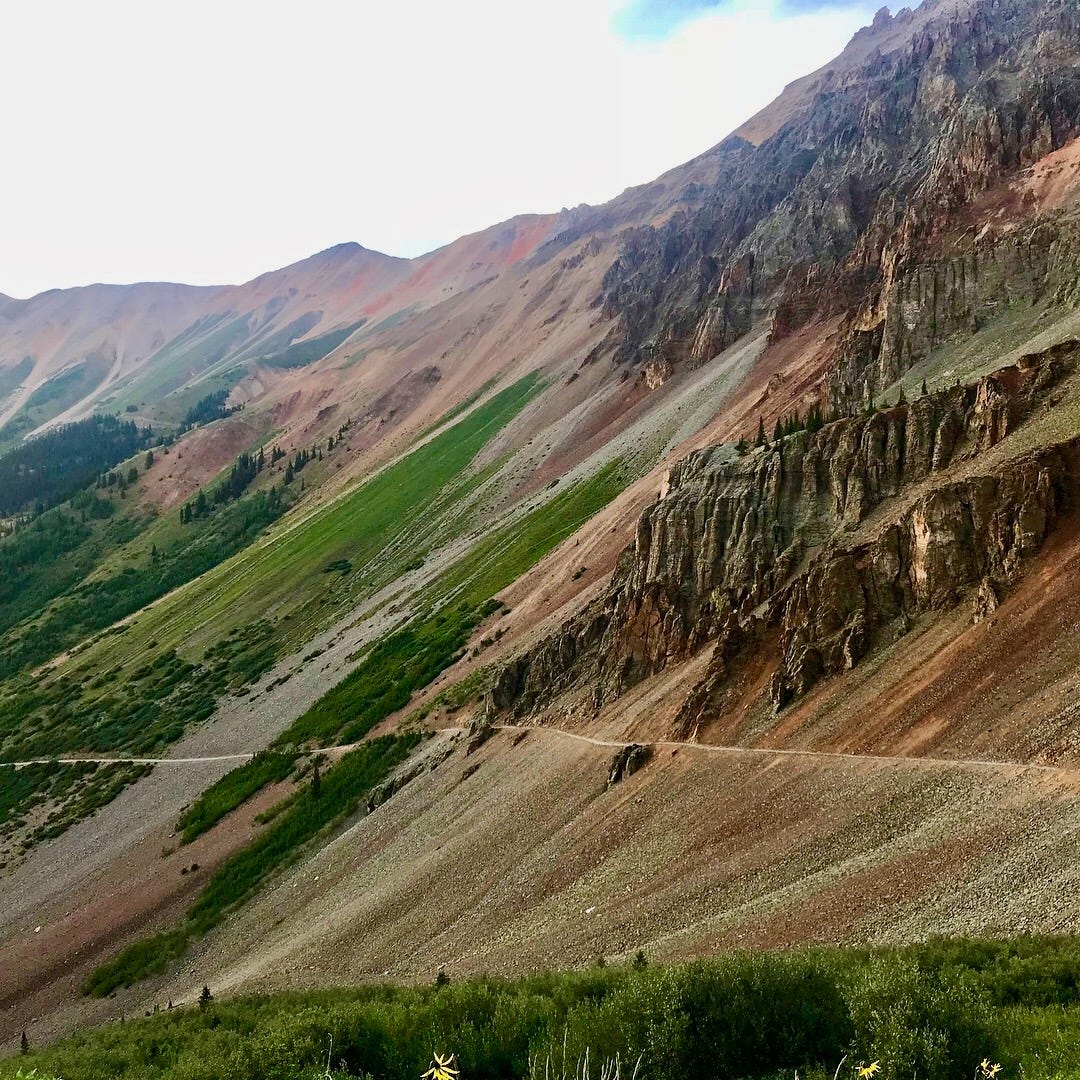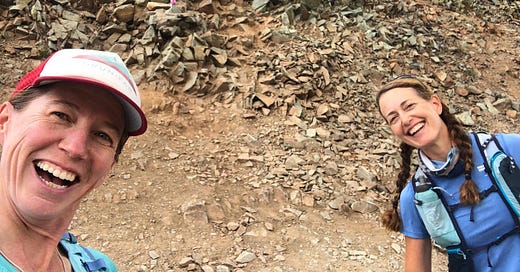You Only Get One Shot, Do Not Miss Your Chance
A training update plus a conversation with Meghan Hicks of iRunFar
You recognize the headline, right? Eminem’s “Lose Yourself”—released 20 years ago!—always has a spot on my ultra playlist, and I allude to it to remind myself not to miss the chance to train as well as possible for the goal race on calendar in late July. The line “you only get one shot” does not really apply to my situation, however, because I keep doing these training cycles and big races year after year, but I latch onto it because it reminds me, what if I only had one shot? Or, what if this is the last time I get to do this?
This week you get an extra dose of inspiration and information thanks to a conversation with someone I admire, Meghan Hicks. We talk about mountain running, gear, and two big ultras she has on calendar. But first, a personal update.
Peak Training
I crest the summit of Ophir Pass, elevation 11,789, and transition from hiking to running down the rocky western side. My legs are tired, having traversed this pass a couple of hours earlier—I did the 10 miles from the Ophir side to the Silverton side, highway to highway, then turned around for a double traverse—but this chunky-rock terrain on a steep slope is precisely what I need to practice.
I am at a point in training for summer mountain ultras where I need to normalize longer runs with significant vert. “It’s a no-brainer 20-miler,” I told my friend Heather, who accompanied me. We’re both training for the June 25 San Juan Solstice 50, then four weeks later, I’ve got the High Lonesome 100.
Downhills are supposed to be easier, but this movement takes full concentration and feels as stressful as uphills because the feet must navigate wobbly jagged rocks that cover the surface of the mining road. There is no dirt here, only crushed rock above tree line. It’s as if nature blasted a cobblestone street, breaking and upending all the carefully laid stones so that instead of fitting together, the rocks rest unstable at odd angles, ready to roll. I muse about how “rocky” can be a synonym for “difficult.” And I think about how I typically get passed in races on the downhills by more gutsy and agile runners, and I resolve to do better.
The most challenging terrain lasts only about a mile before smoothing out. By contrast, on the High Lonesome 100 route through the Collegiate Peaks, we have to descend for several miles from a 13,000-foot ridge on mining roads with softball-sized rolling rocks that are rounder than the rock here above Ophir. Last year—the first year I ran High Lonesome—the race director called these rocks “baby heads,” because they are roughly the size and shape of an infant’s head, which is a mental image I’d like to erase but can’t.
I rhythmically plant trekking poles like ski poles to transfer some of the impact from legs to arms. Poles boost my confidence, because if I catch a toe and stumble, then the pole will prevent a fall. But even pole-planting is tricky, because the tips can get stuck in the crevices between rocks, breaking the rhythm and jerking my arm.
I remind myself to lift up my knees, pick up my feet, to have a light-footed stride and avoid tripping. I imagine flowing and floating over this field of rock, to stay relaxed and calm instead of frustrated.
This is all good, I tell myself. It’s what I signed up for. I am doing just fine.

By the time I get to the bottom, I do indeed feel fine, and the next day my legs don’t feel overly fatigued. I am improving. For two weeks following the May 7 Miwok 100K, I rested more and ran less, and now I’m in a groove of higher-volume specific training.
Only seven weeks remain until High Lonesome 100, which amounts to four weeks of peak training capped off by the San Juan Solstice 50, then tapering. This weekend, I have a 50K race in Durango. I decided to deliberately compromise my performance there by using the race as a big training day sandwiched in a three-day long-run block, so instead of resting the day prior, I’ll do a longer training run, plus a longer recovery run the day after the 50K. This way, I hope to simulate a three-day high-volume training camp that has proven effective in past years.
I love this time of year—I love the motivation and structure that the whopper of an ultra provides. Outside my window, the aspens look bright green from new leaves, and the grass has grown thick enough to let the horses graze. In many ways, this transition to summer is my favorite time of year, before the heat, browning, and smokey sky of August arrive. I feel as fresh as the start of the season.
If you have a goal ultra in mid to late summer, I encourage listening to Koop’s recent podcast about ultra prep. It offers a good overview of what to do and what not to do in the two months prior to an important race. Listening to it while pushing myself up Bridalveil Road above Telluride last Monday, I didn’t learn anything new or groundbreaking, but it reminded me of all the things I should be doing.
For more motivation and advice, I got in touch with Meghan Hicks. I hope you enjoy our conversation below. It turned out long, so I decided to split it in half. I’ll publish the remainder of our Q&A, in which we discuss iRunFar’s coverage and the media landscape, next week.
Meet Meghan
Ten years ago, in advance of my first self-supported stage race (the inaugural Grand to Grand Ultra), I contacted Meghan Hicks for advice because of her stage-racing and fastpacking prowess. She kindly gave me the lowdown on how to eliminate bounce from a lightweight pack, how to use soft medical tape on spots of skin that might chafe, and how to squeeze all the air out of my freeze-dried packaged food to make it as compact as possible. I say “kindly” because she really is kind and always signs her emails, “Kindly, Meghan.”
Meghan is an endurance athlete and sportswriter I’ve always looked up to and who seems older and wiser, even though at 43 she’s 10 years younger than I. We met somewhat by chance in Yosemite Valley in 2010. My husband Morgan and I were there for a five-day adventure while our kids were parked at sleep-away summer camp. Meghan’s then-boyfriend, now-husband Bryon Powell had struck up a casual correspondence with Morgan the prior year, because they both were attorneys going through major career shifts, and Morgan was blogging about being a recovering attorney as we traveled around the world figuring out what to do next. Bryon, meanwhile, was getting serious about monetizing and developing his iRunFar.com blog. If hazy memory serves correct, we met for pizza in Yosemite’s Curry Village, and I learned about Meghan’s background in environmental education and communications for national parks. It seems so long ago.
Over the past decade, with Bryon as editor-in-chief and Meghan as managing editor, iRunFar.com developed into the premier online publication covering all things related to trail and ultrarunning. Meghan stays on top of who’s who in the rapidly changing roster of elite ultraunners and writes detailed previews and recaps of major races each year, along with gear reviews and in-depth features.
She also stays near the top of the sport competitively. She was the 2013 Marathon des Sables champ, and in 2016 and again in 2020 set the supported FKT on the Nolan’s 14. (Her 2020 time of 50 hours, 32 minutes stood for about a month until Sabrina Stanley shaved almost two hours off it.) She also came in 3rd in the 2021 Hardrock 100, her third finish there. This post shows her crushing the Nolan’s 14 line in 2020:
All last month, I caught glimpses of her on Instagram stories with adventure buddies Eszter Horanyi and Maggie Guterl doing impressive early-season high-country treks, and I thought, I want to do more of that, too. So once again, I reached out for advice and inspiration, and she kindly obliged.
What follows is part of a Q&A, lightly edited. She talked via Zoom from Silverton, where she lives much of the year (the other part of the year in Moab).
It’s barely June, and you’ve been getting above tree line a lot. Where are you going and how are you making that happen?
Meghan: “Because things are already melting out, you can climb mountains if you go to their southern and western aspects, so I’ve done a half a dozen or so 13’ers so far. I haven’t done any huge camping trips. … We [a group of seven friends] did a quick overnight not too far from here last week. We all have a bunch of ultra-light camping gear, and it was supposed to be really high wind, hail, and snow, and we’re like, ‘let’s go test our gear,’ so we took everything out, the weather hammered, and all the gear performed. It was just an excuse to go be above tree line for the night.”
So you’re saying you deliberately chose bad weather to camp?
“Yeah, but our cars were not that far away, so it was a good situation where we knew the weather was going to be crap to test stuff, and if we needed to bail, then we could bail.”
Tell me about your gear choices. I know the basics of what’s needed, but have you discovered any gear that you’re really excited about?
“I prefer utilitarian gear that is lightweight, durable, you can apply it to lots of different scenarios, and it lasts a long time. To fire off a few pieces of gear in that category: I’ve been using the Scarpa Spin Infinity this year, a great shoe for both long days on hardpack dirt roads and singletrack and mountain scrambling too. They’re lasting a long time. A pack I like to take out—it packs down really small so you can go tag a peak and run back down with it, or you can take it for two nights out—is the Pa’lante Packs Joey fastpack [see iRunFar’s review that Meghan co-wrote]. I’m always wearing a Montbell rain jacket—they make the best rain jackets.”
What map app are you using the most these days? I want to get better at using map apps for route finding, but I haven’t decided which to use, and I’m wondering about the future of Gaia given Outside’s cutbacks [Outside bought Gaia in early 2021, and the media company recently eliminated about 15 percent of its workforce, see story].
“For, like, over half a decade, I’ve relied on Gaia, both the platform on the computer and the app on a smart device, and in the last month, the smart device app has been failing a lot—like, a lot, a lot, during a couple of crucial times when I wanted to use it. I had mapped a route, then I opened my Gaia app to help me navigate out there, and it was completely frozen and wasn’t working. … I haven’t officially converted, but I’ve downloaded the onX app and have been dually downloading my routes to that and Gaia. … onX came from the hunting world and is now making its way to through hiking and trail running. Gaia has great map layers you can purchase that show private land boundaries and snow layers from recent satellite imagery, and onX has all that and more detail, so a lot of people are raving about it. I don’t yet have enough experience to endorse it, but if Gaia keeps failing me, I’ll be switching.”
Have you had any close calls safety-wise recently that taught you anything?
“No. There have been a couple of times we’ve turned around because it just didn’t feel right, whether the rock didn’t feel good when scrambling … or, one time, we were going up a couloir that was mixed with snow, ice, and scree in the afternoon, and the melt was on so things were coming down, so we didn’t feel that safe. I think I’m a fairly low-risk person and high in self-preservation, and I don’t have that ‘I need to tag this peak today’ type of thing.”
How much have you crossed over into mountaineering and climbing? Do you carry rope and wear a helmet?
“I would describe what I do as light scrambling. It’s not true mountaineering. Not technical climbing unless you can climb it without a rope. I’ll occasionally carry traction and an ice axe for early-season stuff, and when it’s scrambling over crappy rock, I’ll wear a helmet, but no technical climbing or technical mountaineering. That’s not in my skill set.” [laughs]

Let’s get back to mountain running. How much of what you’re doing is deliberately training for the July 15 Hardrock 100, and how is your training going?
“I’m doing a totally different thing this year. I’m being trained by [Western States 100 course record holder] Ellie Greenwood.”
Oh my gosh! What made you get a coach?
“Because I’ve been coaching myself for a long time—Bryon used to coach me, like 10 years ago—and I have felt very capable in mountain scenarios, but not fast, and Ellie Greenwood is the queen of fast long-distance running, so I really wanted to work with somebody who has expertise to help me get better at the running part of mountain running.”
My first reaction was, ‘Why choose her since she’s never done a Hardrock type of 100?’ It sounds like you want to be running like you’re running States in between Hardrock’s peaks.
[laughs] “I don’t know if I’ll be that good, but I think she is helping me regain some running efficiency that I probably had lost or had gotten lazy about.”
If you want to take a little over an hour off your best time to get under 32 hours at Hardrock, where do you see yourself making up that time?
“I need to run a little bit more of the flat to rolling stuff I fall into a walk in. And I’ve been poor about going into Hardrock fully rested and tapered—part of that is because the mountains typically open up and snow melts and things get perfect right as you’re supposed to taper for Hardrock, so there’s that temptation to go out there. And, part of it is iRunFar covers Western States, and then Hardrock, fairly back to back, so I am over-busy for work and arrive at Hardrock fatigued and stressed. Those are the two big variables: going in properly tapered and rested, and being able to run some of the flats that I’ve walked in the past.”
Other than Hardrock, are you doing anything else competitively this year?
“I’m entered into The Snowman Race, a five-day stage race in Bhutan in October [approximately 140 miles total]. I don’t have any other plans except to try to get ready to do high-altitude running with 10 or 12 pound pack.”
Inaugural races feel risky to me. Are you nervous about the safety or logistics?
“This team of men and women are phenomenal. There are about 20 international runners and 10 Bhutanese, so it’s a small group, and that’s on purpose to keep it controlled and safe. … It’s in the Himalayas, taking place on a trekking route called the Snowman Route. I read a book fresh out of college about this woman who lived and worked in Bhutan, and she hiked the Snowman Route, and the way she described it was spectacular. Ever since then, I was like, someday Bhutan, and then this race came on the radar.”
You did the 2014 Tors des Geants 205-mile race in Europe before 200s in the U.S. were really a thing. What do you think of this offshoot category of 200-milers, and does it appeal to you?
“I feel like it was a matter of time before people decided 100 miles wasn’t hard core enough, and now 200 isn’t hard core enough so there’s the Moab 238 and Cocodona 250. It’s going to keep growing, I think. It’s human nature to want to do more and try harder. As for me, I don’t think 200-milers are in my future. I’m 43, and I’m well aware we only have so many energy points to expend in our lives, and I think I probably only want to do a couple more 100s, and then I want to spend my energy points on shorter things that take less time to recover from. We’ll see, but that’s where I am now.”
Meghan and I talked more about media coverage of the sport, and where she finds hope in these troubled times. I’ll run the rest of our Q&A next week.
Thank you, Meghan, for sharing your advice and perspectives!
Check out Meghan’s 2016 book, Where the Road Ends: A Guide to Trail Running.









Sarah, your writing is so expressive that I feel your challenges & triumphs